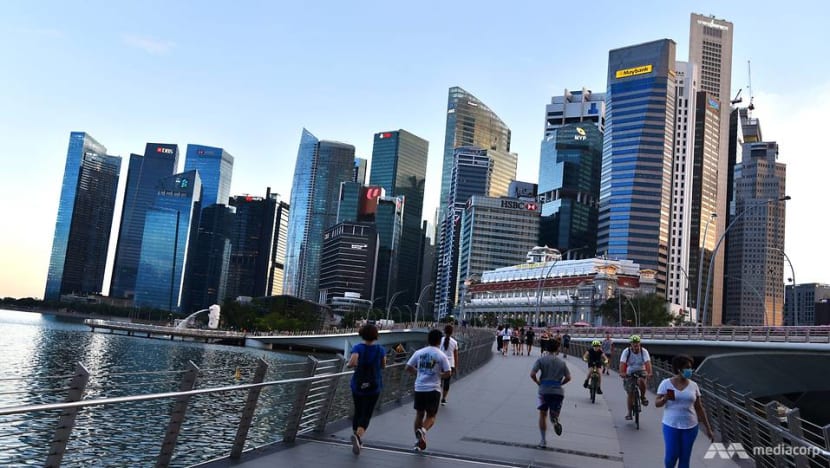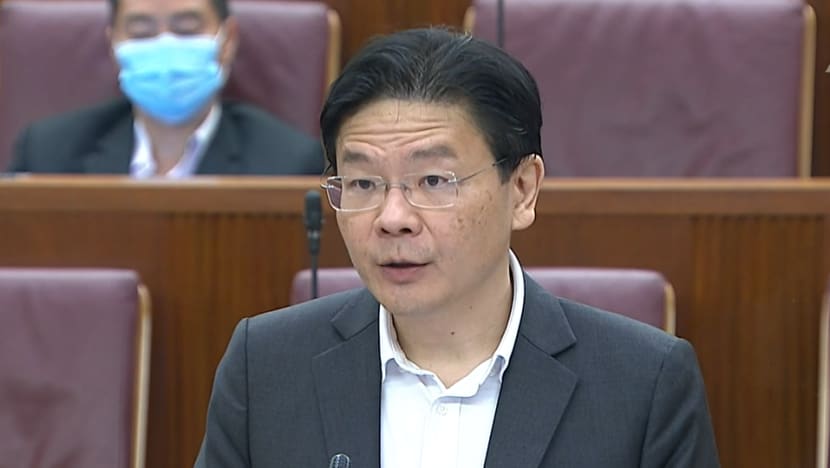Commentary: Push for global corporate tax deal can make Singapore a more compelling investment hub
With BEPS 2.0 minimising tax competition, Singapore can focus investors on its enduring economic fundamentals and retune its tax system, says EY’s Chester Wee.

The Singapore city skyline as seen from Jubilee Bridge (Photo: Jeremy Long)
SINGAPORE: In a momentous milestone for the global economy, over 130 jurisdictions, including Singapore, agreed to the key elements of a two-pillar solution to address today’s international corporate tax challenges in July.
It was a breakthrough the Organisation for Economic Cooperation and Development (OECD) estimates can generate up to US$240 billion annually in foregone government revenues arising from tax avoidance when fully implemented.
Years in the making, such efforts under the OECD/G20 Base Erosion and Profit-Shifting Project (BEPS 2.0) to tackle the tax challenges of the digitalisation of the economy are coming to fruition.
But it’s too early to work out the exact impact on Singapore, Finance Minister Lawrence Wong said in early July.
About 1,800 multinational enterprises (MNE)s in Singapore meet the global turnover criteria of €750 million (US$887 million) for the proposed global minimum tax rules under Pillar Two, with a majority with group effective tax rates below 15 per cent.
READ: What the G7’s global tax reform plan could mean for Singapore
With Pillar One, Singapore profits derived from foreign MNEs with global turnover exceeding €20 billion (US$24 billion) and profit margin above 10 per cent may be reallocated to larger jurisdictions where their customers reside, resulting in revenue loss for the country.
With Pillar Two, the efficacy of Singapore’s tax incentives in attracting investments may be limited by the global minimum 15 per cent corporate tax proposal.

This could potentially increase our tax revenues depending on how it shapes firm decisions and investment choices.
BRINGING BALANCE TO INTERNATIONAL TAX RULES
Singapore has deemed it necessary to sign up to BEPS 2.0. As a member of the OECD Inclusive Framework, it believes a rules-based approach can close cross-border tax loopholes and create a global level playing field.
A world without global tax consensus risks countries taking unilateral actions, imposing greater tax burdens, especially on tech companies with a worldwide presence, and distorting incentives.
This race to tax the digital economy is coming into sharper focus with the rise of Internet companies and digital platforms.
But the result has been a rise in digital services taxes, with varying rules and qualifying conditions for deductions. New anti-base erosion rules are also being enacted. For example, Australia’s integrity rule denies some tax deductions for Australian borrowers.
Under the 2020 Mexico tax reform, some payments made to related parties subject to effective tax of less than 22.5 per cent do not qualify for deductions either.
READ: Commentary: Global minimum tax reflects rich countries' interests, may not generate incomes for others
In such a dynamic tax environment where unique tax rules are being introduced by countries in an uncoordinated fashion on a regular basis, MNEs will struggle to keep up with ever-changing tax rules.
The OECD understands this and therefore has couched BEPS 2.0 as a way to avoid the proliferation of unilateral tax actions and tax uncertainty. They want to minimise global tax compliance costs and tackle double taxation that existing rules do not eliminate.
SUPPORTING INVESTMENTS
The use of tax incentives has been key to Singapore’s strategy in attracting large investments to drive economic growth and job creation. With tax incentives, MNEs could pay an effective tax rate below the headline corporate tax rate.
Yet, Singapore has made various adjustments to its tax incentive schemes over the years to ensure these set high qualifying standards that consider substance and transparency.
READ: Commentary: The global minimum corporate tax rate is coming our way and will change how Singapore attracts MNCs
Tax incentives such as the Pioneer Certificate Incentive and the Development and Expansion Incentive, which encourage companies to grow capabilities and conduct new or expanded activities, demand significant business commitments in terms of headcount and local business spending requirements.
The good news for Singapore is the proposed global minimum tax of 15 per cent eases competition based solely on tax rates. Currently, MNEs can achieve similar tax outcome should they locate themselves in jurisdictions like Ireland (12.5 per cent), Hungary (9 per cent) and Dubai (0 per cent).
Moreover under Pillar Two, a formulaic substance carve-out will be considered, excluding from the low-taxed profit an amount at least 5 per cent of the carrying value of tangible assets and payroll.

This is a compromise for countries and economic zones that have long used tax incentives to attract investments and helps cushion some impact from the global minimum tax proposal. Singapore stands to benefit since the country’s tax incentive schemes are substance-based.
Overall, for smaller nations like Singapore, this curtailing of tax competition from BEPS 2.0 will drive greater focus on economic fundamentals.
Singapore’s longstanding merits in its institutions, infrastructure, labour market and financial and legal systems – qualities it has conscientiously nurtured for decades – would arguably be an even greater source of distinctiveness.
READ: Commentary: COVID-19 has forced the big boys of Singapore business to restructure. Who's next?
NO EXODUS EXPECTED
It is unlikely these new tax rules will lead to an exodus of foreign MNEs in Singapore.
For an MNE headquartered in a G7 country with headline tax rate of 30 per cent or more, Singapore’s headline tax rate at 17 per cent continues to be attractive for it to do business there.
Further, Singapore remains attractive as a hub in Asia, a region that continues to enjoy a promising growth narrative.
Indeed, in a COVID-19 world, the bigger forces working against Singapore are less of these evolving tax rules and more of companies’ shift towards decentralised decision-making and ways of working driven by technological advancement and the need for agility.
READ: Commentary: The coming resignation tsunami - why many may leave their jobs in a pandemic economy

Singapore must upskill its local workforce, and complement it with foreign talent, to support the growth of various technology-driven industries challenged by the current manpower crunch as tech giants scale up their operations there.
With scarcity of land, Singapore needs to think beyond its shores to include its closest neighbouring locations such as Johor, Batam and Bintan as potential areas of operation for MNEs that choose to hub in Singapore.
MNEs can anchor their regional headquarters and R&D activities in Singapore to serve as the Southeast Asia control tower while tapping regionally into more cost-efficient manufacturing solutions.
Facilitating the flow of goods, services, manpower and technology through government-to-government cooperation will be vital to make such multi-hub operating models a success.
REDESIGNING THE CORPORATE TAX REGIME
Even if these global tax rules were not adopted widely, developments in the US would have similar implications as BEPS 2.0 for US MNEs with Singapore presence and Singapore MNEs with US operations.
The Biden Administration’s proposed tax plan dubbed Stopping Harmful Inversions and Ending Low-tax Developments (SHIELD), which seeks to deny deduction for a wide range of payments (including cost of goods sold) made, directly or indirectly, to a low-taxed jurisdiction that does not have a strong minimum tax regime, may compel Singapore to introduce an alternative minimum tax (AMT) or equivalent regime.
READ: Commentary: One of Big Tech’s biggest critics is now its regulator. This has implications for users globally
READ: Commentary: Things are falling apart for US President Joe Biden
An AMT requires corporate earnings to be subjected to a floor tax rate. Such a move can help Singapore avoid any unintentional relinquishment of taxing rights when BEPS 2.0 is in place.
The potential loss of tax revenue for Singapore arising from Pillar One can be backfilled with the added tax collection as a result of implementing Pillar Two and AMT.
The added tax revenue can then be channeled to support businesses in the form of grants, subsidies and financing as alternative tools, in the absence of tax incentives, to attract targeted investments into Singapore.
READ: Commentary: Under-taxed profits of multinationals could fund higher public spending in post-pandemic recovery
That said, reforming the country’s longstanding corporate tax regime is not a small feat to rush into. Singapore should continue to monitor the global adoption of BEPS 2.0 and the US tax developments when redesigning its corporate tax regime.
Chester Wee is EY Asean International Corporate Tax Advisory Leader.
The views in this commentary are those of the author and do not necessarily reflect the views of the global EY organisation or its member firms.














